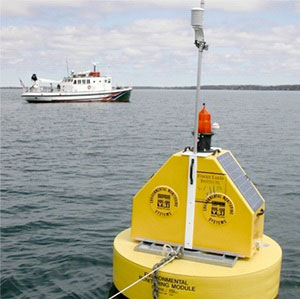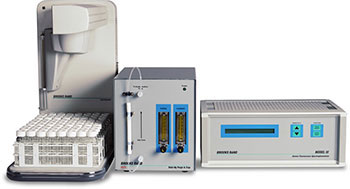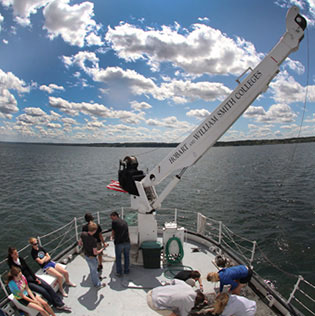Research
Research projects carried out by FLI faculty and collaborators are primarily interdisciplinary and focused on issues relevant to the Finger Lakes region. Research projects provide background information and insights about the regional environment, and include, but are not limited to:

FLI buoy used to monitor water quality in Seneca Lake.
- Watershed/Limnology, hydrogeochemistry, and ecology of the Finger Lakes ecosystem
- Invasive species introductions and their ecological impacts
- Macroinvertebrate and small fish as bioindicators of watershed quality and health
- Mercury and trace metals in water, sediments, and biota
- Records of environmental and climatic change
- Energy generation, utilization and environmental impact
- Meteorological influences on Finger Lakes and Great Lakes systems
- Hydrology and water resource issues
- Human interactions and their effects on water quality
Annual Finger Lakes Research Conference
The Finger Lakes Institute at Hobart and William Smith Colleges hosts an annual research conference on the campus of Hobart and William Smith Colleges. This conference provides an opportunity to learn about the research being conducted in and applicable to the Finger Lakes.
Finger Lakes Buoy Data
The Finger Lakes Institute operates two YSI water quality buoys across the Finger Lakes.
Funded by Cayuga County, the Owasco Lake Buoy platform collects water quality information at evert depth twice a day at a fixed location in Owasco Lake including the following parameters:
- Water Temperature
- Specific conductance
- Dissolved Oxygen
- Turbidity (light backscattering)
- Chlorophyll-a (fluorescence)
In addition, the buoy platform has a meteorological system that make continuous meteorological measurements including:
- Air Temperature
- Barometric Pressure
- Light Intensity
- Relative Humidity
- Wind Speed
Data from the Owasco Lake buoy can be accessed via this website.
A similar buoy is operated on Seneca Lake and data updates will be posted soon.
Facilities, Equipment, and Other Resources
There is a ~700 square foot laboratory in the Finger Lakes Institute that houses equipment that is used for research and education purposes. For field investigations, the FLI has a YSI hand-held physical-chemical meter (YSI-556), a Smith Root Backpack Electrofisher combo unit, an Ekman dredge, secchi disks, plankton nets, and numerous dip nets. Other field instruments deployed for the Finger Lakes Stream Monitoring Network include Vernier Labquest units with dissolved oxygen and temperature probes, LaMotte nitrate and chloride kits, and Oakton pH probes.

Sediment samples from the Finger Lakes being analyzed for total mercury using the FLI’s Milestone DMA-80 analytical system.
The FLI also has ten Zeiss compound microscopes and two dissecting microscopes for identification of biological organisms such as phytoplankton, periphyton, macroinvertebrates, and macrophytes.
For laboratory analysis of total mercury, the FLI houses a Milestone Direct Mercury Analyzer (DMA 80) that is used for analysis of solid phase samples such as biological tissue and sediments. This instrument combines the techniques of thermal decomposition, catalytic conversion, amalgamation, and atomic absorption spectrophotometry for analysis. Limits of quantitation for liquid and solid phase samples based on blank sample boat analyses were determined to be 0.02 ng and 0.01 ng, respectively.
In 2016, the FLI also acquired a Brooks Rand Instruments MERX-M automated methyl mercury analyzer. This instrument enables measurements of solid samples with ultra low methylmercury concentrations, such as benthic invertebrates and zooplankton. Mercury is detected on a Brooks Rand Model III cold vapor atomic fluorescence spectrophotometer, with an instrument detection limit of <0.002 ng/L.

The MERX-M automated methylmercury analyzer. Photo credit: Brooks Rand Inc.
The FLI lab also has an analytical balance and drying oven for sample preparation.
Other resources for environmental research and education exist across the Hobart and William Smith Colleges campus. These include the following:
Shared Field Equipment:
- William Scandling, our 65-ft Research Vessel with crane, winch with ~500 m ¼” cable, DGPS, depth finders, radar, radios, cell phone, captain and crew, etc.
- JB Snow, our 25-ft Pontoon Boat, trailer, 4 kW, 220V Yamaha generator, winch with 250 m of ¼” cable, Lowrance LCX-104 DGPS/WAAS depth finder
Field equipment deployable from the William Scandling and the JB Snow:
- Sea Bird SBE-19 CTD’s – Electronic conductivity, temperature, depth profilers with stainless steel cages, dissolved oxygen and pH sensors and PC computer for communications. One CTD also has a SeaTech 25” path-length transmissometer. (2)
- Standard limnologic and oceanographic equipment including secchi disks, plankton nets (80 and 150 micron mesh), sediment sieves, ~1.7 and 10 liter General Oceanics Niskin water sample bottles, LaMotte chemical analysis kits, microscope with digital display on laptop, pH meters, conductivity meters, thermometers, etc.
- McLane PARAFLUX 21-sample sediment traps (8)
- Piston Corers (ETH and Alpine designs), Gravity/Piston Corer (Benthos) & Grab Samplers (two standard ponar dredges)
- Aanderaa RDCP 600 Doppler Current Profilers
- Aanderaa RCM-4 and RCM-7 Current Meters
- Hugrun Seamon mini temperature recorders
- RBR Temperature Recorders
- EdgeTech’s X-Star Sub-bottom High-Resolution (1 to 12 kHz) Seismic Profiling System
- EdgeTech’s AS-600 Side-Scan SONAR (50 or 200 kHz)
- Navigation Marker Buoys for Deployed Instrument Arrays
Other Geoscience Field Equipment

Sediment sampling on the R/V William Scandling.
- Trimble Pathfinder Pro DGPS System
- Handheld GPS units, Garmin GPS76 WAAS handheld GPS receivers (7)
- Speedtech Depthmate depth sounders (6)
- Marsh-McBirney Model 2000 Flowmate portable flow meter
- An array of HWS Data Loggers
- Standard field geology gear including Bruntons, Silvas, rock hammers, sledge hammers, tents, sleeping bags, etc.
- Conductivity, DO, pH, bailers, stream flow (pigmy) and other handheld meters for field work
- YSI/Endeco Water Quality Profiler & Meteorological Station: EMM-2500 Buoy Platform, with wind speed and direction, air temperature, barometric pressure, relative humidity, and solar radiation sensors and 6600-D Multi-Parameter Water Quality Logger with depth, conductivity, temperature, fluorescence, and turbidity probes.
Geoscience Analytical and Computer Equipment:
- Costech CHNS Elemental Analyzer
- Sartorius CP2P Microbalance
- Beckman Coulter LS 230 Laser Diffraction grain-size analyzer
- Dionex DX-120 Ion Chromatograph & Autosampler
- Rigaku Multiflex X-Ray Diffractometer
- Labconco 4.5 Freeze-Dry System
- SPEX sample mill/pulverizer
- McCrone Micronizing Mill
- Vreeland Spectroscope
- Genesys 10-vis Spectrophotometer
- Spectronix 21D, 10-cm Pathlength Spectrophotometers
- Bartington MS-2 Magnetic Susceptibility Meter with detection loop
- Digico Spinner Magnetometer
- Schonstedt AD-Demagnetizer with six-axis spinner
- Leica DMR phase contrast and MZ8 microscopes with analog photographic system
- Leitz, Olympus, Bausch and Lomb and other petrographic microscopes
- Computer lab with ArcGIS capabilities
- Laptop computers on mobile cart with ArcGIS capabilities (15)
- Analytical balances (2), drying ovens, muffle furnaces, refrigerators, freezers, etc.
- Rock saws, rock crushers, sand sieves, thin section making equipment.
Geoscience & Environmental Studies Research Lab Space:
- Meteorology/Climatology Lab with meteorological software and dedicated workstations to analyze radar data, climatological surface data, digital elevation models, and large meteorological databases
- Hydrogeochemistry Research Lab with Barnstead water system for routine limnological wet chemistry and a separate space for the Ion Chromatograph
- Sedimentology and Paleoclimatology Lab for routine sediment preparation and a separate space for the CHNS analyzer and laser particle size analyzer, as well as storage space for field equipment.
- 30×40-ft Pole Barn to store the pontoon boat and associated field equipment.
Biology Analytical and Computer Equipment:
- Conviron Environmental Growth Chambers (6)
- Fisher Upright Incubators (6)
- Percival environmental chambers (3)
- Lecia MZ 12 dissecting microscope
- Lecia compound student microscope
- Lecia Scope-mounted camera
- Olympus BH2 Compound Microscopes (12)
- Wild Stereo Dissecting Microscopes (12)
- Zeiss Axioskop40 Microscope
- Zeiss Axioskop Fluorescence Microscope
- Zeiss Inverted Microscope
- Balance (top loading)
- Folsom plankton splitter
- Bench-top pH meter
- Bench-top DO meter
- Plankton counting chambers (12)
- Demoninators for zooplankton enumeration
- Mesh and Brass sediment sieves set for size fractioning (6)
- YSI hand-held physical-chemical meter (YSI-556)
- LI-COR light-meter
- Zooplankton Puget Sound Closing nets (1) 0.5m diameter, 153μm mesh (1) 0.5m dia. 500μm mesh
- Vertical Zooplankton nets (1) 0.5m diameter 500μm mesh (2) 0.25m dia. 80μm mesh
- 30-L Schindler Patalas trap
- 15cm paired PVC sediment traps for live collection (3)
- Millipore water system
